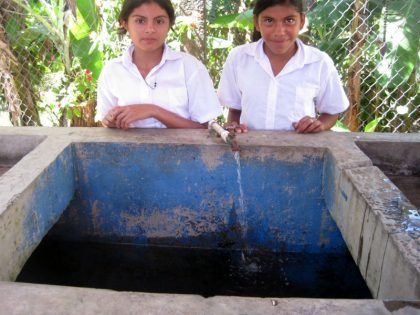 This project has been completed under the direction of Peace Corps Volunteer Courtney Hereford. To read about the beginning of the project, CLICK HERE.
This project has been completed under the direction of Peace Corps Volunteer Courtney Hereford. To read about the beginning of the project, CLICK HERE.
The project was to deepen the school well to provide a reliable source of water throughout the entire year.
Courtney reports:
The Cerro de Nubes (Hill of Clouds) receives a vast quantity of rain during the “winter” months, June through November; and “winter” in this context simply implies the presence of rain. However, the other six “summer” months are nearly totally dry. The toughest months are February, March, April, and May, when there is a country-wide shortage of water.
This particularly affects those communities furthest from the ocean and other bodies of water, and especially those in El Salvador´s northern mountainous areas. A super rural community rising 1000 meters above sea level in the northeastern mountains, Cerro de Nubes is one such place. We have no access to potable water and, in conjunction with the falling water level, the whole community more or less dries up in these severely dry months.
After receiving the project funds in mid-April, we began to look for workers within our community. At the beginning of May, following the conclusion of the celebrations of Semana Santa (the week of Easter), our in-community workers (Alejandro and Carlos) began working on deepening the well.
We have several obstacles to these well projects. One is our especially rocky soil here in Cerro de Nubes. Our whole community is built on rock, with huge rock structures coming out of the ground at all angles throughout the community. This further attributes to our greatest obstacle: the inadequate tools we have at our disposal here.
The workers must cut down several large tree branches to make a rig and pulley to then lower one worker down the well. This worker is only tied in by a rope around his waist, which makes this job especially dangerous. Once at the bottom of the well, the worker must carve out the rock by hand with a hammer and chisel. When he has a full bucket of rock, the other worker pulls the bucket up, empties it, and lets it back down. At mid-day, the workers trade places. They were working 7 to 8 hours a day, four to five days a week, and averaging 20 cm in depth to the well each day.
Thus, I spent a great part of April and May meeting with people in the pueblo of Corinto to find someone who had access to a power drill we could use to more effectively and efficiently dig the hole. Unfortunately this attempt never materialized, as the single owner of such a tool in Corinto had leased it to a construction company in the city of San Miguel a few hours away.
By the end of May, we had managed to deepen the well by about half a meter. The community workers had to stop in order to work in the fields, so we hired two men from the pueblo of Corinto. These workers started in early June and continued until mid-July. We still had to rely on this relatively simple deepening method, and by mid-July we had achieved approximately a meter and a half in depth.
Our goal was to deepen it by five meters. However, by this time there was ample water to put an end to any further work. Moreover, by this time there was little money left, and we used the remainder to hire an electrician to reconnect the tubing and electricity which powers and pumps the water from our well to our water tank, and then to a water basin which we use for all of the daily activities here at the school.
All in all, the project was a success. It took twice as long as we expected to deepen the well half as much as we desired, but the important thing is we currently have sufficient water. We expect this project will sustain our water needs through the next several summer dry seasons here at the school.
From everyone here at the Centro Escolar Cerro de Nubes, we sincerely appreciate your support and consideration in our endeavor to provide adequate water for our team!
We wish to thank Courtney for The Soneva SLOW LIFE Trust for providing the funding.